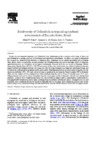Use este identificador para citar ou linkar para este item:
http://biblioteca.incaper.es.gov.br/digital/handle/item/2102Registro completo de metadados
| Campo DC | Valor | Idioma |
|---|---|---|
| dc.contributor.author | CULIK, M. P. | pt_BR |
| dc.contributor.author | SOUZA, J. L. de. | pt_BR |
| dc.contributor.author | VENTURA, J. A. | pt_BR |
| dc.contributor.other | Mark Paul Culik, CNPq/Incaper; Jacimar Luis de Souza, Incaper; Jose Aires Ventura, Incaper. | pt_BR |
| dc.date.accessioned | 2016-08-12T13:44:49Z | - |
| dc.date.available | 2016-08-12T13:44:49Z | - |
| dc.date.created | 2002 | pt_BR |
| dc.date.issued | 2016-08-12 | pt_BR |
| dc.identifier.other | 12216 | pt_BR |
| dc.identifier.uri | http://biblioteca.incaper.es.gov.br/digital/handle/item/2102 | - |
| dc.description | Despite the environmental importance of Collembola, basic information on the occurrence and ecology of these soil microarthropods is lacking, especially in Neotropical and agricultural environments. To address such gaps in information this research was conducted with objectives to determine what Collembola species inhabit agricultural soils of Esp??rito Santo, Brazil; obtain a record of the seasonal abundance of Collembola in this area; and to investigate effects of alternative agricultural practices on Collembola in this tropical environment. Research field sites are located in Domingos Martins municipality, Esp??rito Santo (20°23?S, 41°03?W) and consist of three sites: (A) fertilizer site, with two fertilizer treatments, organic fertilizer and inorganic fertilizer; (B) tillage site, with two tillage treatments, no tillage and conventional tillage; and (C) mulch site, with two mulch treatments, mulch and no mulch. Experimental plots have received similar treatments since the sites were established (1991, 1992) and a variety of crops are grown on the sites annually. From December 1999 to November 2000, soil core samples (4.8 cm diameter) were taken randomly from the surface 10 cm of each plot every 28?71 days. Tullgren funnels were used to extract Collembola from the soil samples and the Collembola collected were identified and quantified. A total of 9650 collembolan specimens was collected from 88 samples taken at approximately 2 month intervals, averaging 60,600 Collembola per meter square, including 38 species and three probable new species. Averaged across sites and treatments, total collembolan density was greater in September than in December. Total collembolan densities were greater with no tillage versus conventional tillage and with mulch versus no mulch. | pt_BR |
| dc.language | en | pt_BR |
| dc.publisher | APPLIED SOIL ECOLOGY, v. 21, n. 1, p. 49-58, july 2002. | pt_BR |
| dc.subject | Collembola | pt_BR |
| dc.subject | Tropical biodiversity | pt_BR |
| dc.subject | Agroecosystems | pt_BR |
| dc.subject | Brazil | pt_BR |
| dc.subject | Espírito Santo (Estado) | pt_BR |
| dc.title | Biodiversity of collembola in tropical agricultural environments of Espírito Santo, Brazil | pt_BR |
| dc.type | Artigo de periódico (quando a biblioteca tiver o título do periódico) | pt_BR |
| dc.ainfo.id | 11482 | pt_BR |
| dc.ainfo.lastupdate | 2016-08-12 | pt_BR |
| dc.ainfo.depositante | Merielem Frasson | pt_BR |
| Aparece nas coleções: | Memória Técnica do Incaper  | |
Arquivos associados a este item:
| Arquivo | Descrição | Tamanho | Formato | |
|---|---|---|---|---|
| BRT-BiodiversityofCollembolaintropicalagricultural2002.pdf | 1,93 MB | Adobe PDF |  Visualizar/Abrir |
Os itens no repositório estão protegidos por copyright, com todos os direitos reservados, salvo quando é indicado o contrário.
